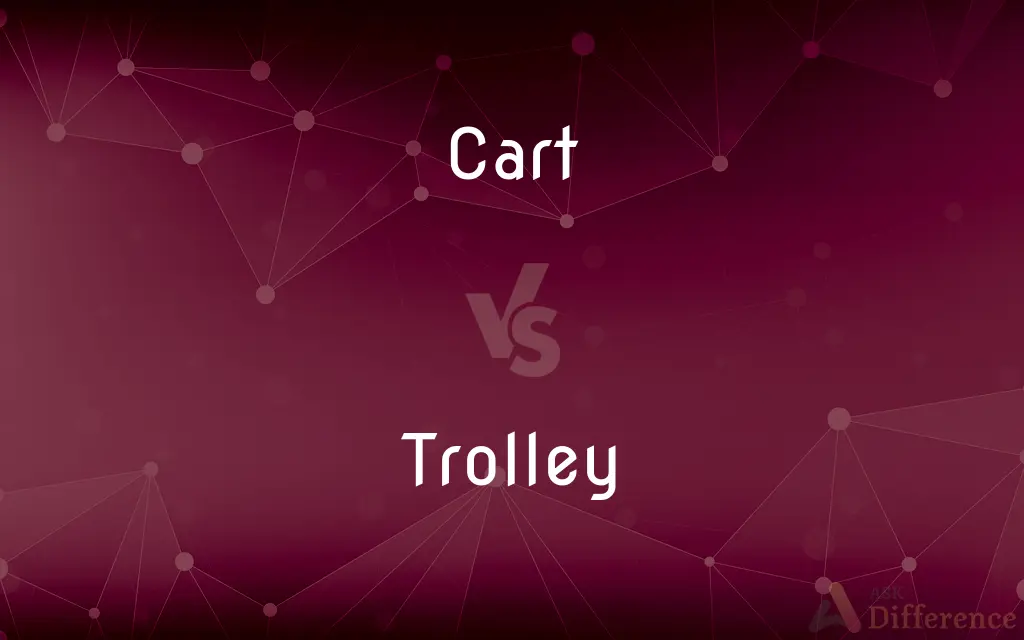Cart vs. Trolley — What's the Difference?
By Tayyaba Rehman & Maham Liaqat — Updated on March 4, 2024
A cart is a wheeled vehicle typically used for transporting goods or materials, often manually pushed or pulled, whereas a trolley is a wheeled platform, either manually pushed in a retail setting or an electrically powered vehicle running on tracks.

Difference Between Cart and Trolley
Table of Contents
ADVERTISEMENT
Key Differences
Carts are versatile wheeled vehicles designed for various applications, from shopping in supermarkets to moving materials in industries. They are generally lightweight and easy to maneuver, making them suitable for personal or commercial use. On the other hand, trolleys can refer to two distinct types: one is similar to carts and used in shopping centers and supermarkets for carrying goods, known as shopping trolleys in some regions.
While carts are primarily manual vehicles that can be pushed or pulled by a person, trolleys, in the context of public transportation, are powered by electricity and travel along predetermined tracks. This distinction highlights their different uses: carts for manual transport of goods and materials, and trolleys for moving people or heavy loads over longer distances with less human effort.
The design of carts focuses on functionality and ease of use, with features like flatbeds, baskets, or sides to contain and secure loads. They are adaptable to various tasks, such as carrying luggage at airports or tools and materials on construction sites. Conversely, trolleys designed for shopping are similar to carts but are specifically tailored for a retail environment, with a main basket for goods and sometimes additional features like a child seat. Electric trolleys, however, are built for passenger comfort and efficiency, equipped with seating, standing areas, and often facilities for disabled access.
In terms of operation, carts are straightforward, requiring human power to push or pull, making them accessible and easy to use for people of all ages. Trolleys in retail settings operate similarly but are usually larger and designed to carry more goods. Electric trolleys, however, require an operator or driver and a power source, such as overhead electric cables, making their operation more complex and their use more specialized.
Despite these differences, both carts and trolleys share the common purpose of transporting goods or people. Their design and operation reflect the specific needs they fulfill, whether it's the simple task of moving shopping items or the more complex requirement of urban transportation.
ADVERTISEMENT
Comparison Chart
Definition
A wheeled vehicle for transporting goods.
A wheeled platform for goods or an electric vehicle on tracks.
Primary Use
Moving goods or materials manually.
Transporting goods in retail or passengers in urban areas.
Power Source
Human (pushed or pulled).
Human or electricity (for public transport trolleys).
Design Features
Often lightweight, with flatbeds or baskets.
Shopping: similar to carts; Transportation: equipped for passenger comfort.
Operation
Manual by pushing or pulling.
Manual for shopping; powered and operated by a driver for transportation.
Compare with Definitions
Cart
A wheeled vehicle for carrying small loads.
He used a cart to transport the books across the library.
Trolley
Equipped for specific uses, like transporting passengers.
The city's trolleys are accessible to people with disabilities.
Cart
Mobile equipment for transporting goods in various settings.
The gardener pushed a cart filled with tools.
Trolley
A wheeled frame for carrying heavy items, especially in supermarkets.
He grabbed a trolley to do his weekly grocery shopping.
Cart
A lightweight, maneuverable vehicle.
At the airport, luggage carts are available for passengers.
Trolley
An electrically powered vehicle running on tracks.
We took the trolley downtown to avoid parking hassles.
Cart
Designed for ease of use and versatility.
The utility cart in the workshop holds various tools.
Trolley
Operates on a fixed route within urban areas.
The historic trolley tour is a popular attraction.
Cart
Often manual, requiring physical effort to move.
She pulled the shopping cart through the grocery aisles.
Trolley
Requires an operator when used for public transportation.
The trolley driver navigated through the busy streets.
Cart
A cart or dray (Aus. & NZ) is a vehicle designed for transport, using two wheels and normally pulled by one or a pair of draught animals.
Trolley
A large metal basket or frame on wheels, used for transporting heavy or large items, such as supermarket purchases or luggage at an airport or railway station.
Cart
A small wheeled vehicle typically pushed by hand
A shopping cart.
A pastry cart.
Trolley
A wheel attached to a pole, used for collecting current from an overhead electric wire to drive a tram.
Cart
A two-wheeled vehicle drawn by an animal and used in farm work and for transporting goods.
Trolley
A small truck or car operating on a track and used in a mine, quarry, or factory for conveying materials.
Cart
A small, open, wheeled vehicle, drawn or pushed by a person or animal, more often used for transporting goods than passengers.
The grocer delivered his goods by cart.
Trolley
A trolley pole; a single-pole device for collecting electrical current from an overhead electrical line, normally for a tram/streetcar or a trolleybus.
Cart
A two-wheeled vehicle for the ordinary purposes of husbandry, or for transporting bulky and heavy articles.
Packing all his goods in one poor cart.
Trolley
A truck which travels along the fixed conductors in an electric railway, and forms a means of connection between them and a railway car.
Cart
Wheeled vehicle that can be pushed by a person; may have one or two or four wheels;
He used a handcart to carry the rocks away
Their pushcart was piled high with groceries
Trolley
To use a trolley vehicle to go from one place to another.
Cart
Transport something in a cart
Trolley
A form of truck which can be tilted, for carrying railroad materials, or the like.
Trolley
A wheeled vehicle that runs on rails and is propelled by electricity;
`tram' and `tramcar' are British terms
Common Curiosities
Are carts and trolleys interchangeable in retail settings?
In some regions, the terms are used interchangeably to refer to shopping carts/trolleys, though they may have design differences.
What is the primary use of a cart?
Carts are primarily used for manually transporting goods or materials in various settings.
How are carts and trolleys powered?
Carts are manually pushed or pulled, while trolleys can be manual or electrically powered for transportation.
Do all trolleys require tracks to operate?
While electric trolleys for public transport run on tracks, manual trolleys in retail or industrial settings do not.
How do carts benefit commercial settings?
Carts enhance efficiency and convenience in moving goods around in settings like warehouses, supermarkets, and workshops.
Can carts be used for transporting people?
Generally, carts are designed for goods, though some specialized carts may transport individuals, such as in airports or hospitals.
What are the key design features of a cart?
Carts are designed for functionality and ease, with features like baskets or flatbeds for carrying loads.
What are the environmental benefits of electric trolleys?
Electric trolleys produce fewer emissions compared to buses and cars, contributing to cleaner urban transport.
How does a trolley differ from a cart?
A trolley can refer to a shopping cart or an electric vehicle on tracks for public transport, differing in use and power source from a manual cart.
What makes electric trolleys suitable for urban transportation?
Electric trolleys are efficient, can carry many passengers, and follow fixed routes, making them ideal for urban public transport.
Can trolleys be found in all cities?
Not all cities have electric trolley systems, as their presence depends on urban planning and infrastructure.
Why might someone choose a trolley over a cart in a supermarket?
Trolleys, as referred to in some regions for shopping, offer more space for goods, making them preferable for large shopping trips.
How do manual trolleys and carts contribute to accessibility in public spaces?
They provide convenient options for transporting goods and personal items, enhancing mobility for shoppers and travelers.
What role do carts play in logistics and supply chains?
Carts are essential for efficient material handling, moving products within facilities, and aiding in the loading and unloading processes.
What distinguishes an electric trolley from other public transport?
Electric trolleys run on tracks with overhead electric cables, offering a unique mode of urban transportation.
Share Your Discovery

Previous Comparison
Switch vs. Change
Next Comparison
House vs. DwellingAuthor Spotlight
Written by
Tayyaba RehmanTayyaba Rehman is a distinguished writer, currently serving as a primary contributor to askdifference.com. As a researcher in semantics and etymology, Tayyaba's passion for the complexity of languages and their distinctions has found a perfect home on the platform. Tayyaba delves into the intricacies of language, distinguishing between commonly confused words and phrases, thereby providing clarity for readers worldwide.
Co-written by
Maham Liaqat













































